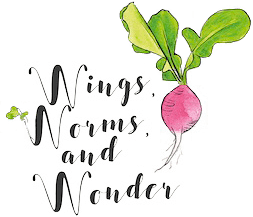To Pick or Not To Pick: a mini-course in harvesting, Part 2
Tuesday we covered the harvesting basics that we can control, so today let’s look at some things we can’t control, but how we can stay on top of them for great harvests.
Weather: It seems that farmers and weather have been at odds since the beginning. I remember my grandpa always worrying about rain and hand watering his entire big garden by hand everyday. I literally mean by hand, carrying buckets a block back and forth all day long because where his garden was located was not near a water source, hose, irrigation, nothing. Pretty admirable I think.
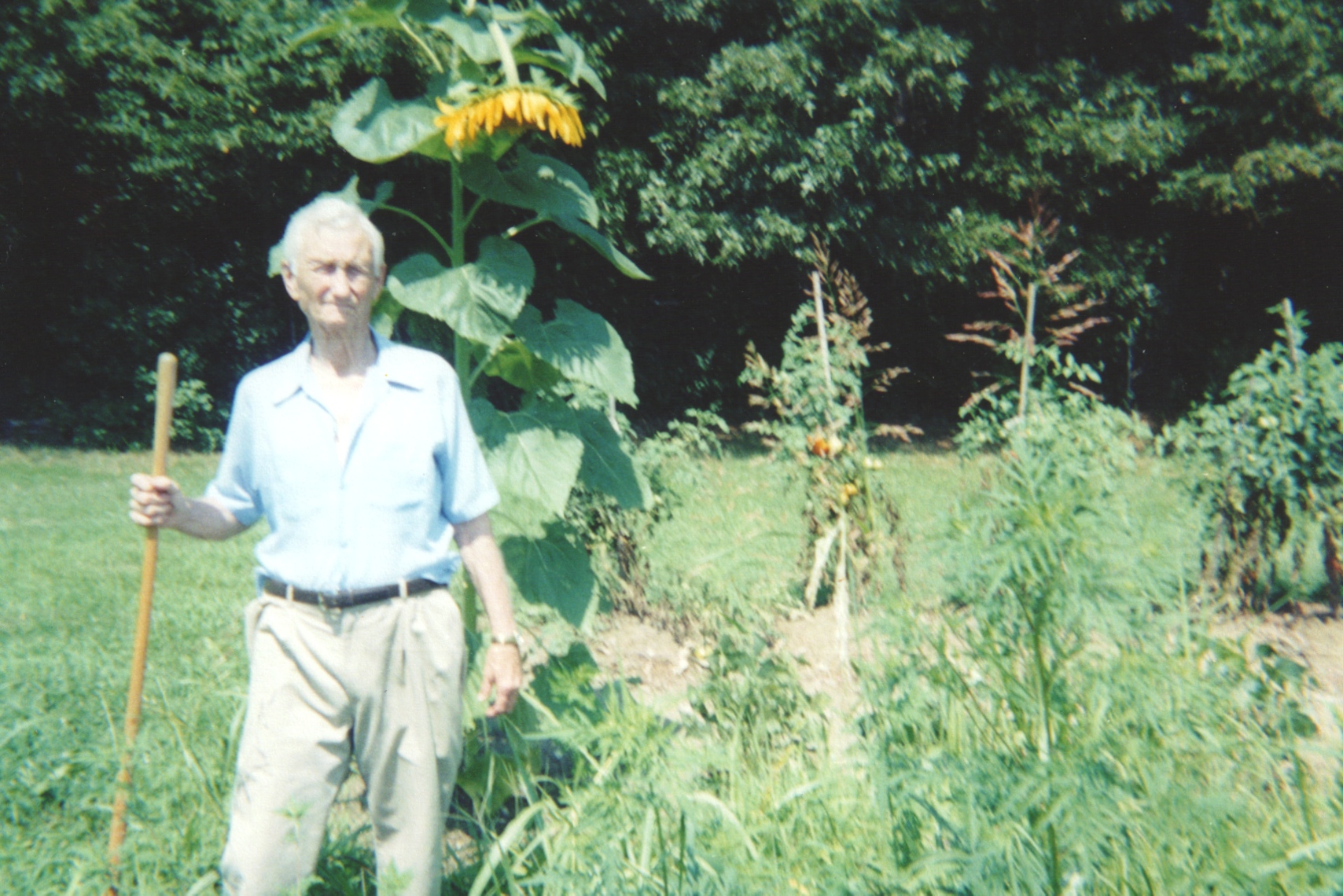
This is my grandpa in his garden, where I learned to grow food.
We often think about gardens not having enough water, which we can supplement, but what about when we have too much rain? This is a tough one. Fields can get flooded out in the blink of a thunderstorm, destroying all the crops the water covers. Melons and tomatoes are especially sensitive to too much water and will split and rot in one afternoon thunderstorm after a dry spell. The best we can do is try to keep the water consistent, but when we can’t and a big multi-day storm is coming, harvest as much as you can. Many fruits like tomatoes, figs, melons, peppers, and squash will ripen on the counter when they are close to ripe.
Others, like beans, may fare the storm better than more tender juicier fruits, but beware of high winds for taller plants as the stalks can break killing the plant and try to reinforce a bit where you can. Watch the forecasts, harvest regularly to stay on top of things, and do the best you can to pick as much is ready before a big storm In the end some things will have to fend for themselves, but we can do our best to set them up for success! As soon as possible after the storm get out to the garden and harvest anything else that may have gotten knocked off the plant or slightly damaged but is salvageable, and then refrigerate.
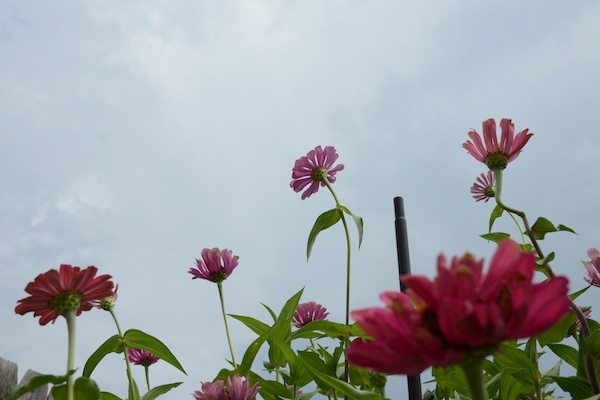
The afternoon storm’s a comin’ ( I barely made it inside!)
Bugs: This is a never ending one, so I’m going to touch on a couple basics that are specific to harvesting. The more you are out in the garden, the earlier you will notice bugs moving in. Some of the most annoying are the worms that bore into the cucumber and squash. There are a few species, but common names are melon worm or pickle worm. Keep an eye out for their holes and in nearly mature fruits harvest immediately when you find a hole. The fruit will most likely still be edible if you just cut the part with the worm in it off and refrigerate the rest. (And feed the worm to a chicken!)
Aphids are a constant garden harvest nuisance. Also know as plant lice (totally gross I think because I got lice in 2nd grade) they love the sweet plants like okra and black eyed peas. You may go out of town for the weekend and come back to find that black aphids have covered your bean pods to the point where the entire pod looks black. Fortunately they are easy to remove. Blast the plant with the hose (be sure to get the undersides of the leaves on plants like okra) or if you are harvesting anyway, run your hand down the pods and scrape them off. This also smashes them and will get your hand really messy so you may want to have an old rag or bucket of water nearby to wash off the aphid bodies. Aphids may make the pods or fruits look a little less perfect, but if managed they won’t effect your harvest and dinner!
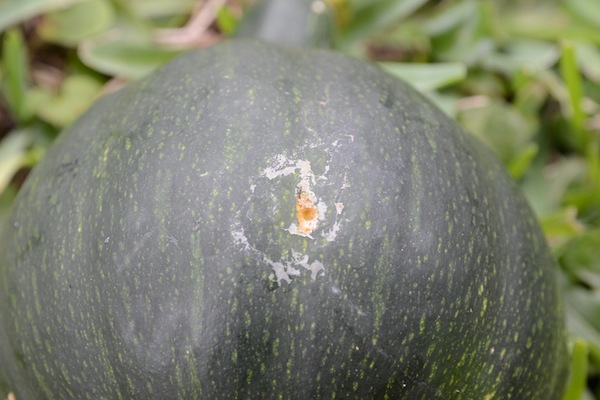
 This is a close up of the worm holes that you will find in your cucurbits (cukes, squash, melons). Sometimes when the hole is fresh you will see a little pile of chewed (?) insides next to the hole.
This is a close up of the worm holes that you will find in your cucurbits (cukes, squash, melons). Sometimes when the hole is fresh you will see a little pile of chewed (?) insides next to the hole.
Ants. These are funny garden critters because they farm other bugs in the garden, like aphids. The ants want the sweet juice that the aphids suck from the plant, so they farm it! You may find that ants start little colonies in the armpits of your eggplant plants. They will actually bring soil up and start little nests. It is pretty weird and I don’t have the reason why they do this, but they don’t seem to effect the plant’s health, until or unless you also start to see mealy bugs with them. The mealy bugs look like white cotton and suck the sweet juice form the plant like aphids. If you find this happening, blast the mealy bugs off with the hose and treat organically for the ants.
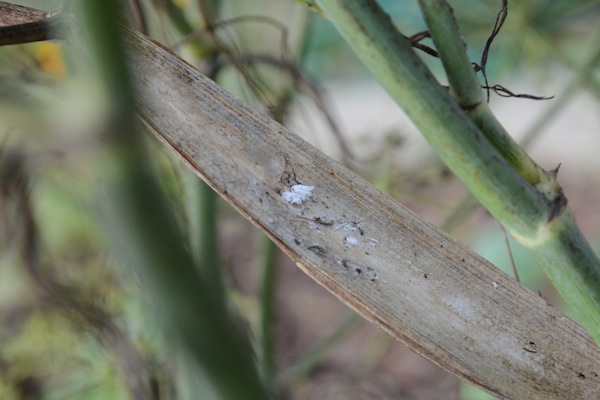
See that white fuzzy stuff? That is mealy bug.
Birds: Birds are great pest control and totally charming in the garden until they start taking bites out of your fruit. Look for smallish holes and nibble bites for signes of bird visits. If you stay on top of it you can catch the fruit before it rots and pick it, cut off the nibbled section, and refrigerate for later use. Some people hang pie pans or CDs up in their gardens to detract birds, but I think that generally, in small songbird type numbers, they are more helpful than harmful in the school or backyard garden. I just plant a little extra to share and put my bird feeders in a different section of the yard.
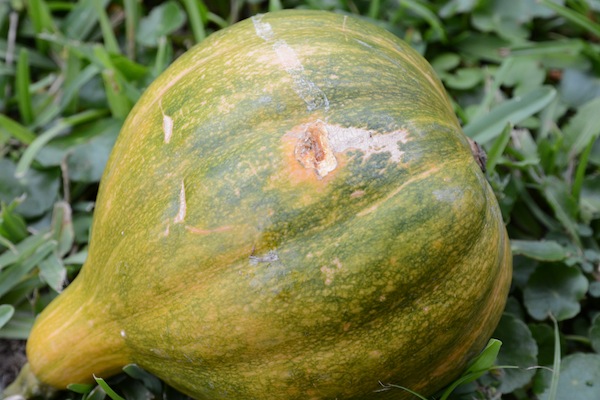
Bird nibbles are a little messier. See how it is less uniform and bigger than the worm’s hole? Both squash are still fine to eat though. Just cut out the nibbled portions and enjoy!
Deer, raccoon, and larger animals: These animals are perhaps the most frustrating and disheartening harvest pests. You have been waiting all summer for that perfect pepper and the morning you go to harvest, it’s gone. A thief came in the night and took it and ate it, you hope, rather than just wasting it. Gardeners have driven themselves crazy for years trying to fight these critters. A good fence is a good start, maybe even with a top depending on your thief. There are also some organic deterrents with mixed reviews you could try too. All I can say to this one is keep trying and try to maybe get a laugh out of their cleverness?
Fungus: This is a bummer when it attacks your fruit. You may have a great looking squash that starts to rot at the end. This is called blossom end rot and is a nutritional deficiency that can be cured with calcium. Fungus can also hit when there have been multiple hot wet nights in a row. To try to avoid this, watch the weather and harvest as much as you can before the rainy weather and if you don’t mind getting wet, harvest during the afternoon to avoid the fruit sitting wet all night.
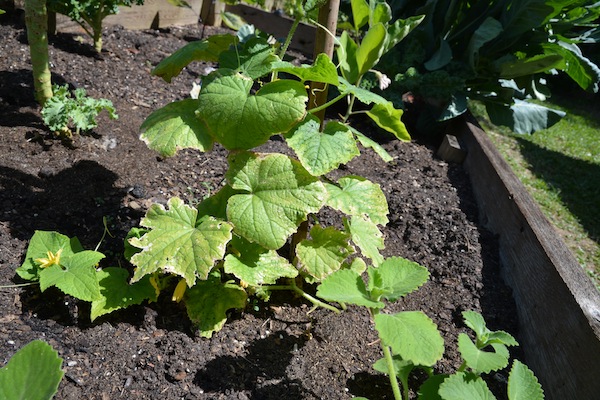
See the yellowish tan crustiness around the edges of this cucumber plant’s leaves? This is the start of a fungus that kills my cukes every year. The night humidity gets them every time.
And Finally the one you’ve been waiting for. The most advance harvesting technique there is……
Intuition: It may sound silly to some, but just like anything you are familiar with, you start to have a sixth sense about it. When you attune with your plants, you can interpret their needs and the ways you can best grow with them. The more time you spend in the garden, the more seasons you harvest during, the more mistakes you make, the more you will learn and become familiar with what and when the plants need and are ready for. So relax, open yourself up, listen, let the intuited knowledge flow, and roll in the bountiful harvests!
Have any advanced harvesting tips or tricks of your own? Share them in the comments below!
Don’t be shy! Share pics of your garden thieves, nibbles, split skins, storm damage and more on Instagram #wingswormsandwonder
Help others learn from your experiences!
Seeds to Sprout:
Interested in the human connection with plants and how we can open oursleves up to connecting? Check out these books: (Use these Amazon links to check them out and then buy them from your local independently owned bookstore!)
Reconnecting With Nature by Michael J. Cohen. This is a great one with actual exercises you can do to deepen your connection with nature by taping into your 53 senses through organic psychology techniques.
The Lost Language of Plants and The Secret Teachings of Plants by Stephen Harrod Buhner. These are great books that delve into science, psychology, history, and medicine as they explore the human relationship with the plant world.
Listening to Nature by Joseph Cornell. This is a book of nature poems and quotes illustrated with beautiful nature photos that you can use for reflection and meditation on deepening your relationship with nature. Great for sparking wonder in adults.

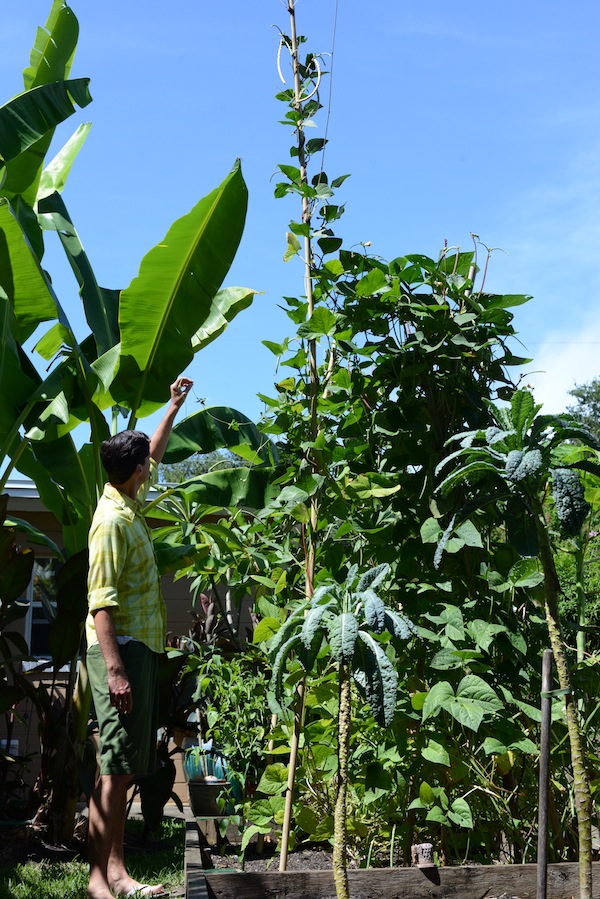
Get to know your plants and you will know when they are in need. Go ahead, poke and prod, they won’t fuss! You can build a relationship with a plant and intuit it’s needs the same way you can a pet. We just have to make time to listen and learn the language.
